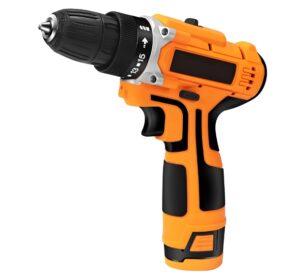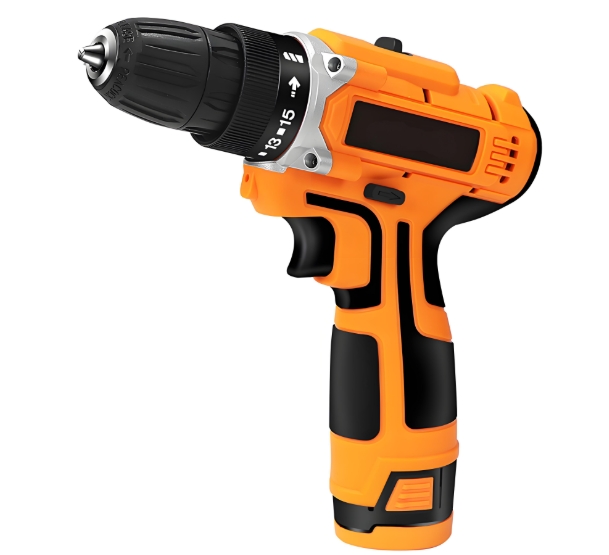When selecting an electric screwdriver motor, several key factors come into play. These factors not only determine the performance and functionality of the electric screwdriver but also influence its suitability for different applications. From power output to durability, each aspect requires careful consideration to ensure that the chosen motor meets your specific needs.
Torque is one of the most crucial factors when choosing an electric screwdriver motor. It refers to the rotational force that the motor can generate, which directly impacts the screwdriver’s ability to drive screws into various materials. Higher torque values mean the screwdriver can handle tougher tasks, such as driving large screws into hardwood or metal.
For light – duty tasks, such as assembling furniture made of softwoods or working with small electronics, a motor with a torque range of 3 – 5 Newton – meters (N·m) may be sufficient. Brands like Bosch offer models like the Bosch GO 2 in this category. The Bosch GO 2 features a compact design and a 4 N·m torque, making it ideal for DIY enthusiasts and basic household repairs. Its built – in clutch system helps prevent over – tightening, protecting both the screws and the materials being worked on.
For more medium – duty applications, such as installing cabinet hardware, building decks, or general construction tasks on softer materials, motors with a torque range of 5 – 15 N·m are more appropriate. The Dewalt DCF680N is a popular choice in this segment. With a maximum torque of 13 N·m, it provides enough power to handle a wide variety of medium – sized screws and bolts. It also has a variable – speed trigger, allowing users to control the speed according to the task at hand, which is an important feature when dealing with different materials and screw sizes.
For heavy – duty applications, like automotive repairs, construction on hard materials such as concrete – embedded fixtures, or industrial assembly work, motors with torque values exceeding 15 N·m are necessary. The Makita XFD10R is a high – torque electric screwdriver motor. It can deliver up to 50 N·m of torque, making it capable of driving large and tough screws into the most demanding materials. This kind of high – torque motor is often used in professional settings where reliability and power are essential.
The speed of an electric screwdriver motor is another important consideration. Speed is typically measured in revolutions per minute (RPM). A higher RPM allows for faster screw driving, which can significantly increase productivity, especially in tasks that involve driving a large number of screws.
Low – speed motors, with speeds ranging from 200 – 500 RPM, are suitable for tasks that require precision, such as driving small screws in delicate electronics or working with materials that are prone to splitting, like thin plywood. The Ryobi P215 has a low – speed setting of around 300 RPM, which makes it a good option for these types of tasks. It also has a higher – speed setting for more general applications, providing versatility.
Medium – speed motors, with speeds between 500 – 1500 RPM, are suitable for most standard household and light – construction tasks. They offer a good balance between speed and control. The Black + Decker BDCS20C has a variable – speed range that reaches up to 1300 RPM. This allows users to quickly drive screws into materials like softwood, drywall, and plastic, while still maintaining enough control to avoid over – driving or damaging the materials.
High – speed motors, with speeds exceeding 1500 RPM, are designed for heavy – duty and industrial applications where rapid screw driving is required. For example, the Milwaukee M18 Fuel FDS18BL can reach speeds of up to 2000 RPM. This high – speed motor is ideal for construction sites and manufacturing facilities where efficiency is key and large numbers of screws need to be driven in a short period.
The battery life and power source of an electric screwdriver motor are critical, especially for cordless models. Cordless electric screwdrivers offer the advantage of portability, but their performance is highly dependent on the battery.
Battery Capacity: Measured in ampere – hours (Ah), a higher Ah value indicates a larger battery capacity and longer run – time. For example, the Hitachi DS18DGL comes with a 1.5 Ah battery. This allows for a decent amount of work before recharging, but for more extended use, models with 2.0 Ah or higher batteries, such as the Metabo BS 18 Quick with a 2.6 Ah battery, are more suitable. These larger – capacity batteries ensure that the screwdriver can be used for longer periods without interruption, which is important for professional users or those working on large projects.
Battery Technology: Lithium – ion (Li – ion) batteries are currently the most popular choice for cordless electric screwdrivers due to their high energy density, long lifespan, and lack of memory effect. Memory effect is a phenomenon where a battery’s capacity decreases over time if it is not fully discharged before recharging. Li – ion batteries do not suffer from this, allowing for more flexible charging. Brands like Festool use advanced Li – ion battery technology in their electric screwdriver models, such as the Festool CXS, to ensure consistent power delivery and long battery life.
Charging Time: The time it takes to recharge a battery is also an important factor. Some models, like the Craftsman CMCSH620C1, come with fast – charging capabilities. It can fully charge its battery in just 30 minutes, which is extremely convenient when you need to get back to work quickly. In contrast, some older or lower – end models may take several hours to charge, which can be a significant drawback in time – sensitive situations.
For applications where cordless operation is not necessary or practical, corded electric screwdrivers are available. Corded models offer unlimited power as long as they are plugged in, making them suitable for continuous use in a fixed location. The Chicago Electric 120 – Volt Variable – Speed Screwdriver is an example of a corded model. It provides a constant power supply and is often more affordable than cordless counterparts, making it a good option for DIY enthusiasts on a budget or for use in a workshop setting.

The size and weight of an electric screwdriver motor can greatly affect user comfort and usability, especially during extended use.
Compact and lightweight electric screwdrivers are ideal for tasks that require working in tight spaces or for users who need to hold the tool for long periods. The Fasco 6000 Series micro – electric screwdrivers are extremely small and lightweight, designed for precision work in electronics manufacturing and repair. Their small size allows technicians to access hard – to – reach areas with ease.
On the other hand, larger and heavier electric screwdrivers, often those with more powerful motors and larger batteries, are better suited for heavy – duty tasks. For example, the Ingersoll Rand W3153 is a heavy – duty cordless impact driver (which can also be used as a powerful screwdriver). It is relatively large and heavy due to its high – torque motor and large battery, but it is designed to handle the toughest jobs on construction sites and in industrial settings. While it may be less comfortable for extended use in tight spaces, its power and durability make it indispensable for heavy – duty applications.
The clutch system in an electric screwdriver motor is an important safety and functionality feature. It helps prevent over – tightening of screws, which can damage the material, strip the screw head, or cause other problems.
A mechanical clutch system uses a series of gears and springs to disengage the motor from the screwdriver bit when a certain torque limit is reached. The Bosch PS31 – 2A has a mechanical clutch with 11 different settings. This allows users to adjust the torque limit according to the material and the type of screw, providing precise control over the tightening process.
Some newer models feature an electronic clutch system. These systems use sensors to detect the torque and can provide even more accurate control. The Dewalt DCF880 has an electronic clutch that offers 15 different torque settings. It can also provide additional features such as self – tapping screw mode and drilling mode, making the screwdriver more versatile.
The durability and build quality of an electric screwdriver motor are essential for long – term use. Motors with high – quality materials and construction are more likely to withstand the rigors of regular use, impacts, and exposure to dust and moisture.
Housing Materials: Many high – end electric screwdrivers use durable materials such as metal – reinforced plastics or even full – metal housings. For example, the Makita TD110D has a metal – reinforced plastic housing that provides excellent protection for the internal components while keeping the weight relatively low. Metal – bodied screwdrivers, like some models from Hilti, are extremely durable but may be heavier.
Sealing: In applications where the screwdriver may be exposed to dust, water, or other contaminants, good sealing is crucial. The Ryobi P238 has an IPX4 rating, which means it is protected against splashing water from all directions. This makes it suitable for use in outdoor or damp environments.
Motor Construction: High – quality motors use strong magnets, durable windings, and reliable bearings. Brands like Metabo are known for their well – constructed motors. Their motors are designed to have a long lifespan, even under heavy – duty use, due to the use of high – grade materials and advanced manufacturing techniques.
There are several additional features that can enhance the functionality and usability of an electric screwdriver motor.
LED Lights: Many modern electric screwdrivers come with built – in LED lights. These lights illuminate the work area, which is especially useful in dark or poorly – lit spaces. The Black + Decker BDCSE20C has a bright LED light that stays on for a few seconds after the trigger is released, allowing users to see the work area clearly even after the screwdriver has stopped.
Adjustable Handles: Some models feature adjustable handles to improve user comfort and grip. The Milwaukee M12 Fuel FDS12 has an adjustable – angle handle that can be set in different positions, making it easier to work in various orientations and tight spaces.
Connectivity: With the advancement of technology, some electric screwdrivers now offer connectivity features. For example, certain models from Bosch can be connected to a smartphone app via Bluetooth. The app allows users to monitor the battery level, adjust the torque settings, and even track the tool’s location, providing added convenience and functionality.
In conclusion, choosing the right electric screwdriver motor requires a comprehensive evaluation of multiple factors, including torque, speed, battery life, size, clutch system, durability, and additional features. By carefully considering these aspects and understanding the specific requirements of your tasks, you can select an electric screwdriver motor that will provide reliable performance and meet your needs for years to come. Whether you are a DIY enthusiast, a professional contractor, or an industrial worker, there is an electric screwdriver motor out there that is perfect for your applications.


